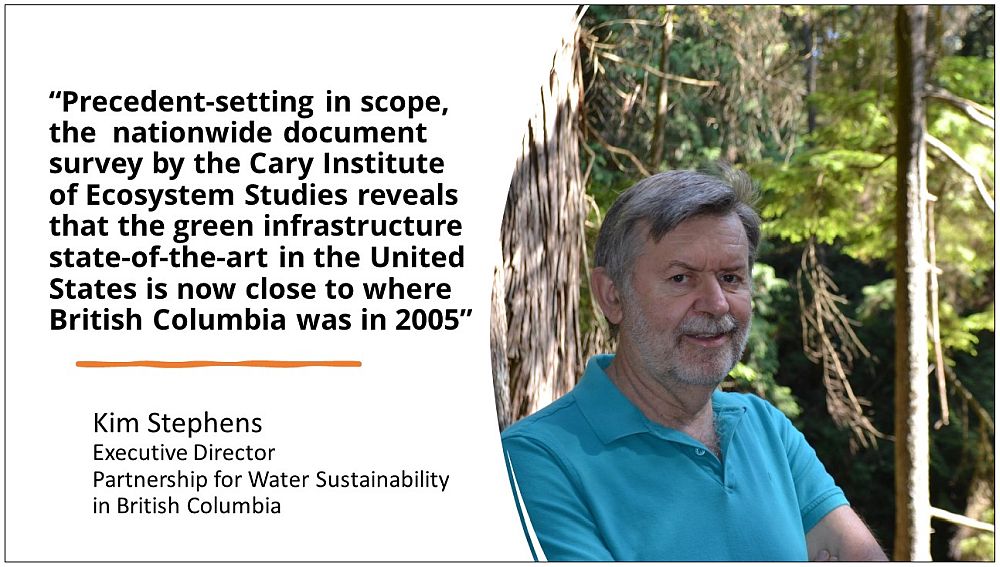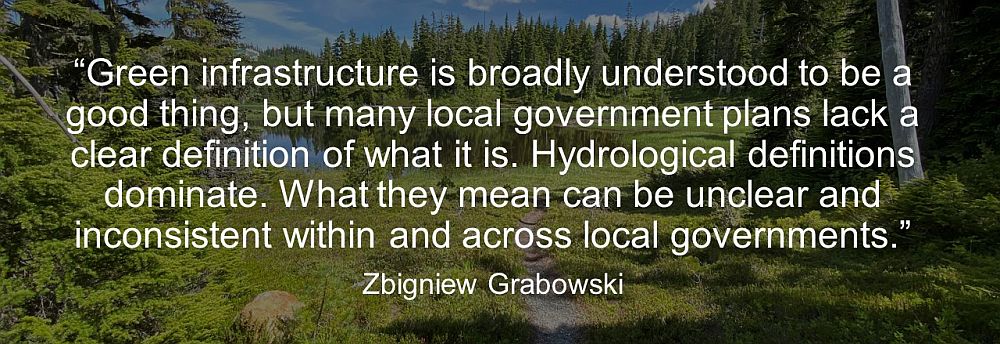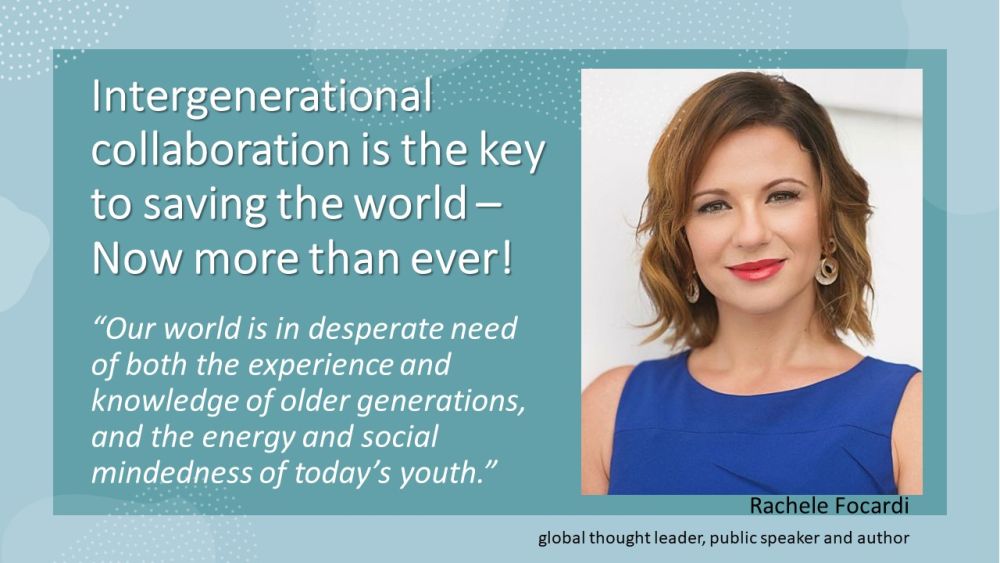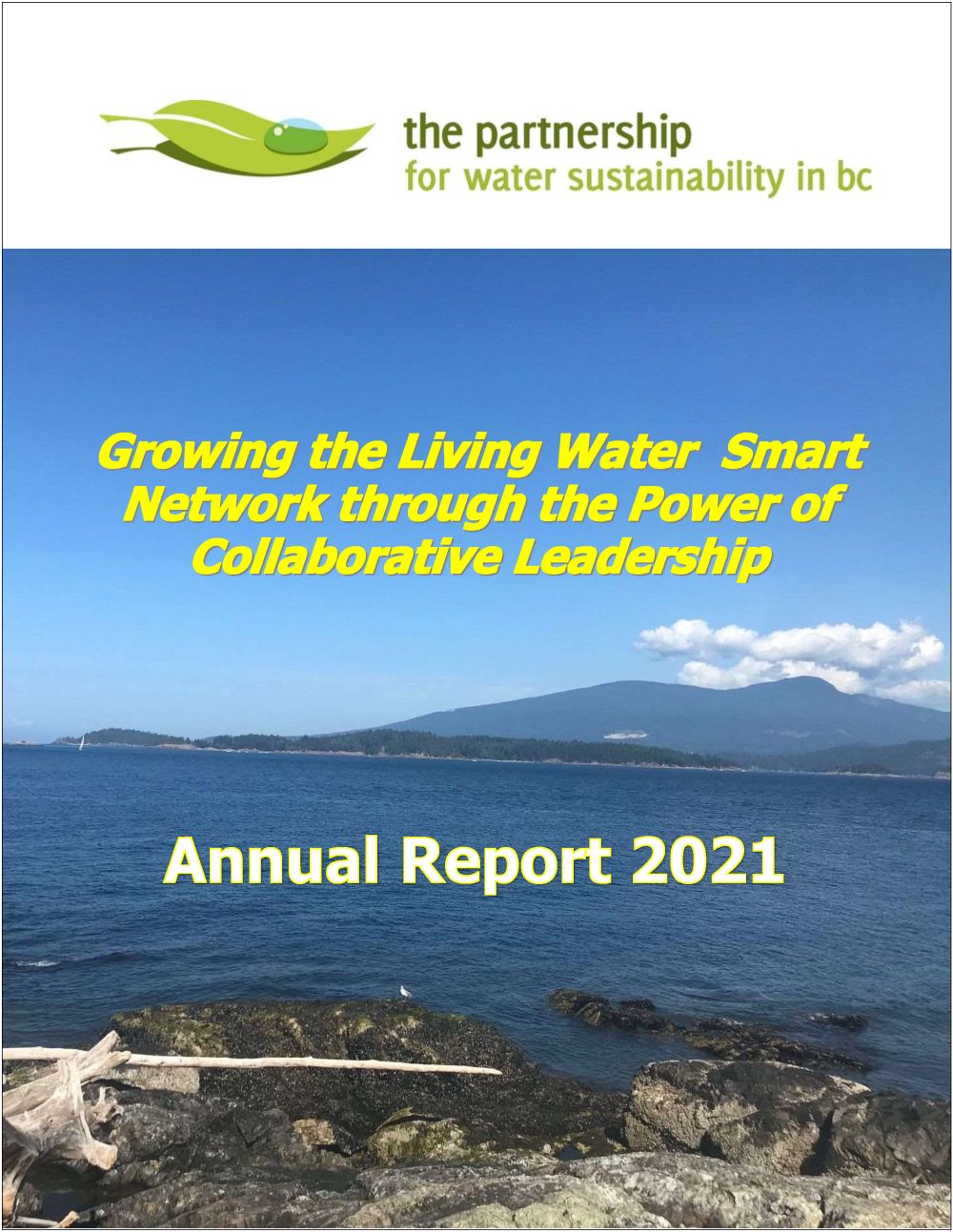‘DESIGN WITH NATURE” FRAMEWORK FOR GREEN INFRASTRUCTURE: Nationwide document survey by Cary Institute of Ecosystem Studies reveals that the green infrastructure state-of-the-art in the United States is now close to where British Columbia was in 2005
NOTE TO READER:
“SHARE INFORMATION. INFORM DECISIONS.” This soundbite lines up nicely with the mission of Waterbucket eNews which is to help our readers make sense of a complicated world. Waterbucket eNews celebrates the leadership of individuals and organizations who are guided by the vision for Living Water Smart in British Columbia to build greener communities and adapt to a changing climate; and embrace “design with nature” approaches to reconnect people, land, fish, and water in altered landscapes.
The edition published on February 15, 2022 featured a conversation with Dr. Zbigniew Grabowski of the Cary Institute of Ecosystem Studies, and Tim Pringle, Chair of the Ecological Accounting Process (EAP) initiative. Dr. Grabowski is the lead author of a nationwide survey titled What is green infrastructure? A study of definitions in US city planning.

30-SECOND TAKEAWAY
If we know how to do a much better job of protecting ecological features and stream systems in our communities and on our landscape, then why aren’t we doing a better job? Why are streams still being degraded in British Columbia and beyond? Why do we still see practices that are embedded in land use policy and regulation that are decades old in some cases? How do we change that?
At best, the ecological services provided by “green infrastructure” have been considered as an add-on. They are not intuitively understood by the public, elected representatives and asset managers. Unless communities measure the effects of impacts, degradation of riparian assets and streamside setback zones will continue.

What is Green Infrastructure, Really?
Released in January, a nationwide analysis of 122 plans from 20 United States cities found that many plans fail to explicitly define green infrastructure. When they do, concluded the Cary Institute of Ecosystem Studies, they tend to focus on stormwater management, favouring engineered facilities over parks and larger urban green spaces. The study is the first systematic review of the use and definition of the green infrastructure concept in local government plans in the United States. The findings may also be viewed as applicable to Canada.
Lead author Zbigniew Grabowski, who completed the work as a postdoctoral associate at Cary Institute of Ecosystem Studies, explains, “Green infrastructure is broadly understood to be a good thing, but many city plans lack a clear definition of what it actually is. Hydrological definitions dominate. This narrow view can limit project funding and cause cities to miss out on vital social and ecological services that more integrative green infrastructure can provide.”
In this edition of Waterbucket eNews, we present highlights from a conversation with “Dr. Z” and Tim Pringle, Chair of the Partnership’s Ecological Accounting Process (EAP) initiative. There are two parts to today’s storyline.
We use the term “green infrastructure continuum” to frame how green infrastructure understanding and the state-of-the-art around it are building on experience and evolving over time. The continuum idea provides context for milestones on the green infrastructure journey in British Columbia.
Curious about the continuum idea? Click on the image below and download the latest document in the Living Water Smart Series. The PDF document is an expanded version of this article.
DOWNLOAD A COPY: https://waterbucket.ca/wcp/wp-content/uploads/sites/6/2022/02/PWSBC_Living-Water-Smart_Green-Infrastructure_2022.pdf

EDITOR’S PERSPECTIVE
“In January 2022 this headline in an American publication caught my attention: Cities are murky on how they define ‘green infrastructure’. The headline distilled a key takeaway from the survey by the Cary Institute. This was a call to action for Tim Pringle and me. And so, we reached out to Dr. Z to have a conversation and compare experience. The conversation was an eye-opener and a trigger for reflection on a larger issue,” stated Kim Stephens, Waterbucket eNews Editor and Executive Director.
Green Infrastructure Continuum as an idea is foundational to our Oral History in British Columbia
“Our partners in provincial and local government tell us that the oral history, and the intergenerational sharing and learning that goes with it, are rapidly being lost. The ramifications of this “new reality” create a sense of urgency to inform and educate BC audiences. First, they need to know about the green infrastructure continuum. And secondly, they need to understand why it is significant, relevant and important as a foundational idea.”

“The continuum idea is a metaphor for hope. It allows us to answer the question, how well are we doing? The green infrastructure continuum is the way we measure progress to achieve the Living Water Smart vision for creating liveable communities and protecting stream health. The lynchpin for achieving these “design with nature” outcomes is intergenerational collaboration, driven by systems thinking. Hope springs from a systematic and adaptive approach that builds on a solid foundation, and consistently gets it right.”
“There is a saying, look back to move forward. When each generation of practitioners understands and cares about the oral history of green infrastructure in a Living Water Smart context, then successive generations of land development and infrastructure servicing practitioners are more likely to select the right path forward at each generational inflection point. Another saying provides a time-based perspective for the intergenerational journey, measure progress by the distance travelled rather the distance still to go.”

Generational Amnesia means
“they don’t know what they don’t know”
“The continuum idea goes to the heart of the unifying theme for our current series of Waterbucket eNews storylines, overcoming generational amnesia. As each new generation inherits the world, vital knowledge is forgotten. Generational amnesia has profound effects on the way that we see the world and what we do. An ongoing challenge is to overcome generational amnesia so that communities learn from historical experience, apply this knowledge, and achieve better policy and financial outcomes.”
“In the 2-part article that follows, the green infrastructure spotlight shines on oral history as viewed through a BC lens. Stories are essential. We learn through stories. They help us see the forest for the trees. Coupled with this, knowledge and expertise flow from a building blocks process. There is no shortcut. The process takes time, commitment, and perseverance. Touching bases with someone from another jurisdiction allows for an informed comparison of where each is at in their journey along the continuum.”
“In Part 1, Dr. Z describes his moment of insight when he uncovered a “a grain of systems thinking within green infrastructure planning”. His revelation is the point of departure for Part 2. It allows us to connect the dots to our milestone in 2005 when BC’s Green Infrastructure Partnership developed a “Design With Nature” framework for a whole-system approach that integrates across infrastructure systems.”
“In summary, we have learned that the state-of-the-art in the United States is now close to where British Columbia was in 2005. In the meantime, we have continued to progress and evolve our systems approach, and this is why Part 2 which is about EAP, the Ecological Accounting Process, is an essential read.”

Part 1: Toward a More Inclusive Definition of Green Infrastructure in the USA – A Conversation with Dr. Zbigniew Grabowski
Green infrastructure has been embraced as a tool to help cities achieve sustainability and resilience goals while improving the lives of urban residents. How green infrastructure is defined guides the types of projects that local governments implement, with enduring impacts to people and the urban environment.
The nationwide survey of plans was by Dr. Zbigniew Grabowski, as part of a larger project examining the equity of GI planning led by two senior scientists (Dr. Steward Pickett and Dr. Timon McPhearson). Originally seeking to identify how cities plan for green infrastructure, the survey was confronted with a diversity of plan types and green infrastructure concepts.
This unexpected diversity required the elaboration of three lines of analysis: the types of local government plans that define green infrastructure, how it is defined, the types of things considered part of GI, along with its functions and benefits.

The realization that led Dr. Z to look at Green Infrastructure through a Social Lens
According to Dr. Z, “Ecology is not really being embedded in any planning practice, This realization turned my attention towards urban planning and this question, how do you embed ecosystem science and principles within landscape planning to conserve landscapes, ecological functions, and quality?”
This led him to look at green infrastructure through the systems lens, “It resulted from thinking about how the social processes shaping landscapes are inseparable from people’s relationship with nature, the ecosystem itself, as well as what infrastructure is present on the landscape. It is not just about ecological assets. It is also about these hybrid ‘built assets’ as well as the range of technological innovations.”

The research question led in an unexpected direction, with a surprising outcome
Dr. Z continued, “The green infrastructure research project started with an overall goal, and that is to examine the equity of green infrastructure plans. But we soon found that cities across the United States define green infrastructure in such different ways. This meant that we had to first survey what they meant by green infrastructure. Only then could we tackle the original research question.”
“Until and unless we did this, it would be impossible to compare apples with apples when all these plans have radically different definitions. So, we had to develop a methodology to characterize what is meant by green infrastructure in the US urban planning context.”
“The survey identified the dominance of the stormwater focus, mostly due to the requirement for compliance with US EPA regulations, but also because of this tradition of landscape conservation planning. We also found that a more integrated systems concept is emerging. And that is what we wanted to promote and push it forward.”
“There are a lot of ‘greening’ and sustainability initiatives, but they are not conceptually unified. They are neither thought about in terms of interdependencies nor systemically.”

Investigative process resulted in the “synthetic definition” of green infrastructure
“In the process, we started to uncover this grain of systems thinking within green infrastructure planning. It is like a crystal within a larger chaotic mix of planning ideas, an idea allowing us to integrate many different infrastructure systems.”
“I have talked to folks at the US EPA. Even within that organization, there is confusion around what green infrastructure means. Maybe, if we just crystalize that nugget of an idea even more, it will catalyze a more structured way of thinking about these things in US urban planning and beyond.”
“We can deal with stormwater, and we can deal with landscape values in conservation. We can do so through a systems framework. By proffering a synthetic definition that places relationships between systems, in order to design a green infrastructure system at its core, we hope our work might be able to advance that conceptual agenda.”

Part 2: British Columbia’s Journey Along the Green Infrastructure Continuum –EAP, the Ecological Accounting Process, shows how to operationalize Systems Thinking
Dr. Z’s epiphany, when he uncovered a grain of systems thinking within GI planning, is the point of departure for this Part 2. It allows us to connect the dots to a GI milestone in 2005 when BC’s Green Infrastructure Partnership (GIP) developed the “Design With Nature” framework for a whole-system approach that integrates across infrastructure systems.
Green infrastructure state-of-the-art in USA now close to where BC was in 2005
Formed in 2003 and co-funded by the provincial government and the Real Estate Foundation, the GIP provided provincial leadership and influenced the nature and direction of the green infrastructure conversation in British Columbia. The work of the GIP is foundational to the Water Sustainability Action Plan for BC and the Partnership for Water Sustainability is “the keeper of the GIP legacy”.
The GIP framed green infrastructure in terms of six objectives for community development. At that time, the mantra was “create liveable communities and protect stream health”. Almost two decades later, this framework mirrors what Dr. Z and his colleagues are now urging in the United States.

“DESIGN WITH NATURE” FRAMEWORK FOR INTEGRATING ACROSS INFRASTRUCTURE SYSTEMS TO “CREATE LIVEABLE COMMUNITIES AND PROTECT STREAM HEALTH”.
The GIP was one of six original elements of the Water Sustainability Action Plan for BC, released in 2004. “Designing With Nature” is foundational to the whole-system, water balance approach of the Partnership for Water Sustainability. Successive initiatives have built on this foundation to this day. The Action Plan informed and is nested within Living Water Smart, British Columbia’s Water Plan, released in 2008.
EAP is a Land Use Perspective
“The story of EAP is how we got to the idea of the stream corridor system as a Natural Commons and connecting it to the challenge for streams to survive in an urban or urbanizing setting. The driver is degradation of stream channels and streamside riparian setback zones. EAP establishes the methodology and metrics for tackling the Riparian Deficit,” Tim Pringle explained to Dr. Z.
“The strength of EAP is in how it looks at and values streams as systems, as natural commons assets, and as a land use. A stream corridor is a land use because it satisfies two criteria: it is defined in the Riparian Areas Protection Regulations Act, and it has a financial value. One can draw a direct line from EAP to the Act, renamed in 2016 after originally becoming law in 1997 as the Fish Protection Act.”
“The land supports assets that provide services. And decisions are made at the parcel scale. Thus, we are tied to the past through historical subdivision of land. This means we must understand the biology of land use. The human analogy is DNA.”
“Getting it right starts at the parcel scale and recognizing that every parcel is interconnected within a system. EAP is the only ecological methodology that deals with the parcel. Getting it right at the parcel scale is a shared responsibility. Everyone involved in land use and development, from start to finish, must understand the goal in doing business differently because the status quo is resulting in unacceptable consequences.”

Operationalizing EAP for Stream System Management and Maintenance
“The essence of EAP is expressed as follows: What is the environment that supports the “package of ecological services” in a stream corridor? This term refers to the combined range of uses desired and supported by the community, namely – drainage, habitat, recreation, and enjoyment of property. This is a land use perspective.”
“EAP interweaves financial, social, and ecological perspectives within a single number to establish the financial case for a stream corridor system. This aggregate number is the Natural Commons Asset (NCA) value. EAP uses BC Assessment data to find the NCA values of streams. BC Assessment parcel data are accurate, recent, and reflect the motivations of buyers and sellers over time. This means parcel values include social, ecological, and financial trend information.”
“The NCA value, a measure of the Riparian Deficit, provides environmental planners with a starting point for conversations with engineers and accountants about the services that natural and constructed assets both provide.”
EAP supports local governments that intend to include stream systems in asset management calculations and the maintenance and management, or M&M, of drainage services. Through use of EAP, local governments can make a financial case for stream systems. The provincial umbrella for EAP is Asset Management for Sustainable Service Delivery: A BC Framework,” Tim Pringle concluded.

About the Partnership for Water Sustainability in BC
Technical knowledge alone is not enough to resolve water challenges facing BC. Making things happen in the real world requires an appreciation and understanding of human behaviour, combined with a knowledge of how decisions are made. It takes a career to figure this out.
The Partnership has a primary goal, to build bridges of understanding and pass the baton from the past to the present and future. To achieve the goal, the Partnership is growing a network in the local government setting. This network embraces collaborative leadership and inter-generational collaboration.

TO LEARN MORE, VISIT: https://waterbucket.ca/about-us/
DOWNLOAD: https://waterbucket.ca/atp/wp-content/uploads/sites/9/2021/11/PWSBC_Annual-Report-2021_version-for-waterbucket.ca_.pdf





